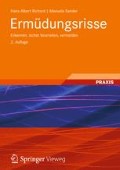Zusammenfassung
Für die Auslegung bzw. für die Bestimmung der Lebensdauer eines Bauteils oder einer Struktur ist die Kenntnis der Beanspruchbarkeit eines Werkstoffs, die der Beanspruchung gegenübergestellt werden kann, von besonderem Interesse. In diesem Kapitel soll deshalb die Ermittlung derjenigen bruchmechanischen Werkstoffkennwerte dargestellt werden, die für das Ermüdungsrisswachstum von Bedeutung sind. An dieser Stelle kann nur eine zusammenfassende Darstellung der Sachverhalte gegeben werden. Für eine detaillierte Beschreibung sei auf die Originalquellen verwiesen.
Access this chapter
Tax calculation will be finalised at checkout
Purchases are for personal use only
Preview
Unable to display preview. Download preview PDF.
Literatur zu Kapitel 5
Blumenauer, H.; Pusch, G.: Technische Bruchmechanik. Deutscher Verlag für Grundstoffindustrie, Leipzig, 1993
ASTM: Annual book of ASTM Standards 2006. Section 3: Metals Test Methods and Analytical Procedures, Vol. 03.01, Metals – Mechanical Testing; Elevated and Low-Temperature Tests; Metallography, E 399–06
ASTM: Annual book of ASTM Standards 2008. Section 3: Metals Test Methods and Analytical Procedures, Vol. 03.01, Metals – Mechanical Testing; Elevated and Low-Temperature Tests; Metallography, E 647–08
Sander, M.; Richard, H.A.: Lebensdauervorhersage unter bruchmechanischen Gesichtspunkten. Materialprüfung 46 (2004) S. 495–500
Sheldon, J.W., Bain, K.R., Donald, J.K.: Investigation of the effects of shed-rate, initial Kmax and geometric constraint on ÄKth in Ti-6Al-4V at room temperature. International Journal of Fatigue 21 (1999) S. 733–741
McClung, R.C.: Analysis of Fatigue Crack Closure During Simulated Threshold Testing. In: Newman, J.C. Jr., Piascik, R.S. (eds.): Fatigue Crack Growth Threshold, Endurance Limits and Design, ASTM STP 1372, ASTM, West Conshohocken, 2000, S. 209–226
Newman, J.C. Jr.: Analyses of Fatigue Crack Growth and Closure Near Threshold Conditions for Large-Crack Behavior. In: Newman, J.C. Jr., Piascik, R.S. (eds.): Fatigue Crack Growth Threshold, Endurance Limits and Design, ASTM STP 1372, ASTM, West Conshohocken, 2000, S. 227–251
Pippan, R., Stüwe, H.P., Golos, K.: A comparison of different methods to determine the threshold of fatigue crack propagation. International Journal of Fatigue 16 (1994) S. 579–582
Hübner, P., Pusch, G., Zerbst, U.: Ableitung von Quantilrisswachstumskurven für Restlebensdauerberechnungen. In: DVM-Bericht 236, Deutscher Verband für Materialforschung und -prüfung , Berlin, 2004, S. 121–130
Newman, J.A., Riddle, W.T., Piascik, R.S.: Effects of Kmax on fatigue crack growth thresholds in aluminium alloys. In: Newman, J.C. Jr., Piascik, R.S. (eds.): Fatigue Crack Growth Threshold, Endurance Limits and Design, ASTM STP 1372, ASTM, West Conshohocken, 2000, S. 63–77
Döker, H.: Schwellenwert für Ermüdungsrissausbreitung: Bestimmung und Anwendung. In: DVM-Bericht 234, Deutscher Verband für Materialforschung und -prüfung , Berlin, 2002, S. 9–18
Tabernig, B., Pippan, R.: Determination of length dependence of the threshold for fatigue crack propagation. Engineering Fracture Mechanics 69 (2002) S. 899–907
Newman, J.C. Jr., Schneider, J., Daniel, A., McKnight, D.: Compression precracking to generate near threshold fatigue-crack-growth rates in two behaviour alloys. International Journal of Fatigue 27 (2005) S. 1432–1440
Forth, S.C., Newman, J.C. Jr., Forman, R.G.: On generating fatigue crack growth thresholds. International Journal of Fatigue 25 (2003) S. 9–15
Plank, R., Kuhn, R.: Automatisierte Risslängenmessung bei Ermüdungsrissausbreitung unter Mixed-Mode-Beanspruchung. Technisches Messen 63 (1996) S. 51–55
Sander, M.: Einfluss variabler Belastung auf das Ermüdungsrisswachstum in Bauteilen und Strukturen. Fortschritt-Berichte VDI, Reihe 18, Nr. 287, VDI-Verlag, Düsseldorf, 2003
Sander, M., Richard, H.A.: Automatisierte Ermüdungsrissausbreitungsversuche. Materialprüfung 46 (2004) S. 22–26
Döker, H.: Fatigue crack growth threshold: implications, determination and data evaluation. International Journal of Fatigue 19 (1997) S. S145-S149
FKM-Richtlinie: Bruchmechanischer Festigkeitsnachweis für Maschinenbauteile. VDMA-Verlag, Frankfurt, 2006
NASGRO®: Fatigue crack growth computer program „NASGRO“ Version 5.2, Southwest Research Institute, 2008
Henkel, S., Hübner, P., Pusch, G.: Zyklisches Risswachstumsverhalten von Gusseisenwerkstoffen – Analytische und statistische Aufbereitung für die Nutzung mit dem Berechnungsprogramm ESACRACK. In: DVM-Bericht 240, Deutscher Verband für Materialforschung und –prüfung , Berlin, 2008, S. 251–259
Richard, H.A., Tenhaeff, D., Hahn, H.G.: Critical survey of Mode II fracture specimens. Int. Conf. and Exposition on Fatigue, Corrosion Cracking, Fracture Mechanics and Failure Analysis. Salt Lake City, 1985
Richard, H.A.: Eine neue KIIC-Probe. Vorträge der 12. Sitzung des Arbeitskreises Bruchvorgänge. Deutscher Verband für Materialprüfung, Berlin 1980, S. 61–69
Richard, H.A.: A new compact sheer specimen. Int. J. Fracture 17 (1981) S. R105–R107
Richard, H.A.: Bruchvorhersagen bei überlagerter Normal- und Schubbeanspruchung von Rissen. VDI-Forschungsheft 631, VDI-Verlag, Düsseldorf, 1985
Richard, H. A.: Specimens for investigating biaxial fracture and fatigue processes. In: Brown, M.W., Miller, K. J.: Biaxial and Multiaxial Fatigue, EGF3, Mechanical Engineering Publications, London, 1989, S. 217–229
Richard, H.A., Fulland, M., Sander, M.: Theoretical crack path prediction. Fatigue & Fracture of Engineering Materials and Structures 28 (2005) S. 3–12
Richard, H.A.: Praxisgerechte Simulation des Werkstoff- und Bauteilverhaltens durch überlagerte Zug-, ebene Schub- und nichtebene Schubbelastung von Proben. Vorträge zur Jahrestagung ’83 „Werkstoff-Bauteil-Schaden“, VDI-Gesellschaft Werkstofftechnik, Düsseldorf, 1983, S. 269–274
Richard, H.A., Kuna, M.: Theoretical and experimental study of superimposed fracture modes I, II and III. Engineering Fracture Mechanics 35 (1990) S. 949–960
Buchholz, F.-G., Richard, H.A.: From compact tension shear (CTS) to all fracture modes (AFM) specimen and loading devices. Proceedings of International Conference an Advances in Structural Integrity. Indian Institute of Science, Bangalore, 2004
Schwalbe, K.H.: Bruchmechanik metallischer Werkstoffe. Hanser-Verlag, München, 1980
Author information
Authors and Affiliations
Rights and permissions
Copyright information
© 2012 Vieweg+Teubner Verlag | Springer Fachmedien Wiesbaden
About this chapter
Cite this chapter
Richard, H., Sander, M. (2012). Experimentelle Ermittlung bruchmechanischer Werkstoffkennwerte. In: Ermüdungsrisse. Vieweg+Teubner Verlag. https://doi.org/10.1007/978-3-8348-8663-7_5
Download citation
DOI: https://doi.org/10.1007/978-3-8348-8663-7_5
Published:
Publisher Name: Vieweg+Teubner Verlag
Print ISBN: 978-3-8348-1594-1
Online ISBN: 978-3-8348-8663-7
eBook Packages: Life Science and Basic Disciplines (German Language)

